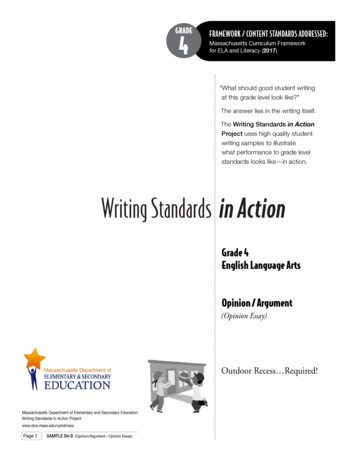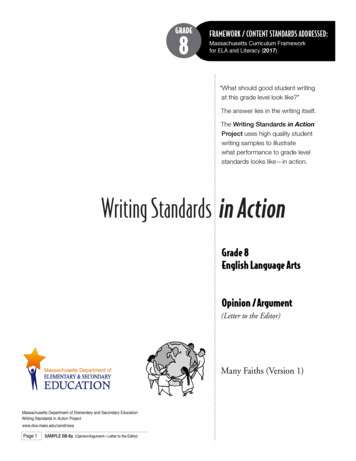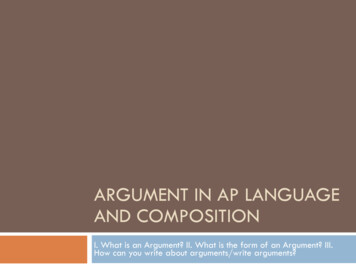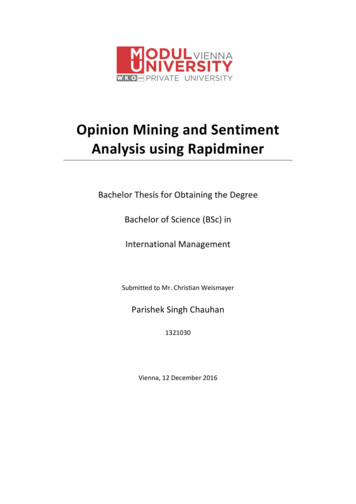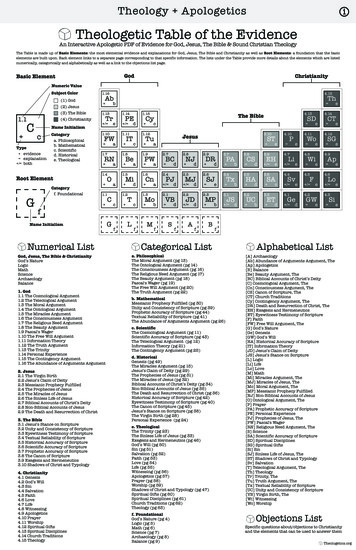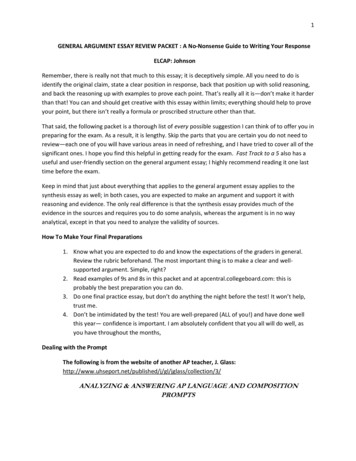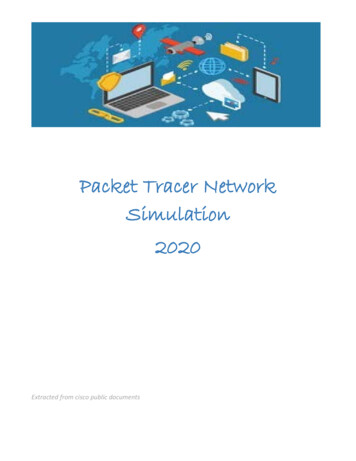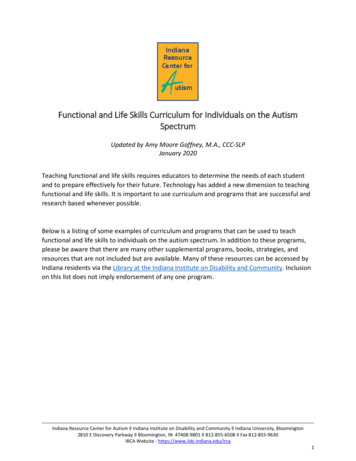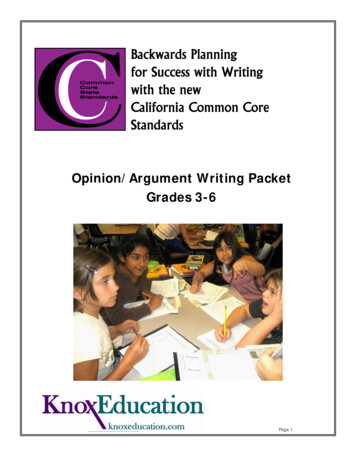
Transcription
Backwards Planningfor Success with Writingwith the newCalifornia Common CoreStandardsOpinion/Argument Writing PacketGrades 3-6 2013 www.knoxeducation.comPage 1
Opinion/Argument Writing – Table of Contents 3-6PageThe New California Common Core Standards (CCCS) Overview3Anchor Standards: College and Career Readiness: Text Types and Purposes4Anchor Standards: College and Career Readiness: Production and Distribution of Writing5Anchor Standards: College and Career Readiness: Research to Build Knowledge6What is an Argument?7Progression of Opinion to Argument Writing8Persuasion vs. Argument9Opinion/Argument and College and Career Readiness – Michelle Karns10Opinion/Argument Writing in the new Common Core Standards – Standards for K-811-12CCCS Anchor Paper Grade 413-14CCCS Anchor Paper Grade 615-16CCCS Writing Rubric for Grade 5-SAMPLE17Write a Sample Anchor Paper with Your Class18Gradual Release of Responsibility Model of Instruction19Teaching Writing – Scaffolding20-21The Writing Process Model22Building Talk Time into the Writing Process23-24Jumpstart25Talk Tickets26-27Six Week Backwards Planning for Success with Writing - Example Planning Sequence of Opinion/Argument Writing Lessons28Week 1: Focus on Modeling and Mentor Texts29Week 2-3: Shared and Guided Writing Plus Guided Writing and Mini-Lessons as Needed30Week 4-5: Focus on Revision and Editing31Week 6: Focus on Sharing and Response Plus On-Demand Dress Rehearsal32Opinion/Argument Writing Tool Kit33Picture Examples of Opinion/Argument Writing34Week 1Opinion/Argument Lesson Sequence for Older Students35Week 1Warming Up to Writing Opinion/Argument Writing with Older Students36-38Week 1Identifying Elements of Opinion/Argument Writing using Color Coding39-40Week 1Teacher Modeling with Color CodingWeek 2Shared Writing of Opinion/Argument Essay42Week 2Writing An Argument/Opinion Essay With Your Students43How to Write an Opinion/Argument Letter44Opinion/Argument Language Frames45Opinion/Argument Essay Planning Guide46Paragraph Frames for Opinion/Argument Writing47Week 141Writing Reviews as Opinion Writing48Review Writing: Basic Structures by Category and Review Writing Planning Form49-50Opinion Writing Organizer51Week 2-3Building a How-To Chart with Your Students52-53Week 3-4Guided Writing54-56Opinion/Argument Rap57-58Explorer’s Argument Advertisement and Essay59-62Cues, Sequences, and Transition Words63-64Ideas for Opinion/Argument Writing: Sample Prompts that Appeal to Students65Opinion/Argument Reading and Writing Vocabulary66-67Writing Checklist: Opinion/Argument Writing 3-668Writing Conference Strategies; One-on-One Conferences; and Conferencing69-72Learning About Revision and Editing73Implementing a Publishing Week in the Primary Classroom74-76The Authors’ Chair77Editing is Fun Poster78The Editing Machine79Resources for Teaching Opinion/Argument Writing80Included are Sections from Backwards Planning for Success with Writing Handbook 2011 Charlotte Knox knoxeducation.com 2013 Charlotte Knox, www.knoxeducation.comPage 2
The New California Common Core Standards (CCCS)College and Career Readiness Anchor Standards Strands Grade Specific K-12READING Key ideas and details SPEAKING and LISTENING Text types and purpose Integration of knowledgeand ideasProduction and distributionof writingComprehension andcollaboration Range of reading and levelof text complexityResearch to build andpresent knowledgePresentation of knowledge andideas Range of writingCraft and structureFOUNDATIONAL SKILLS WRITINGPrint conceptsLITERACY in HISTORY/SOCIAL STUDIES,SCIENCE and TECHNICAL SUBJECTSReading and Writing Standards forContent Area SubjectsPhonological awarenessPhonics and word recognitionFluencyLANGUAGE Grade specific standards Knowledge of languageConventions of standardlanguageVocabulary acquisition anduseAPPENDICESA. Research behind the standards and glossaryof termsB. Text exemplars illustrating complexity,quality, and range of reading appropriateand sample performance tasks for variousgradesC. Annotated samples of students’ writing atvarious gradesThis version adapted from http://gomaisa.com 2013 www.knoxeducation.comPage 3
College and Career Readiness: Standards for WritingText Types and PurposesText TypeAnchor StandardsIn My Classroom1. Write arguments to supportclaims in an analysis ofsubstantive topics or textsOpinion/ Argumentusing valid reasoning andrelevant and sufficientevidence.Informative/Explanatory2. Write informative/explanatorytexts to examine and conveycomplex ideas and informationclearly and accurately throughthe effective selection,organization, and analysis ofcontent.Narratives3. Write narratives to develop realor imagined experiences orevents using effectivetechnique, well-chosen details,and well-structured eventsequences. 2013 www.knoxeducation.comPage 4
College and Career Readiness: Standards for WritingProduction and Distribution of WritingAnchor StandardsIn My Classroom4. Produce clear and coherentwriting in which the development,organization, and style areappropriate to task, purpose, andaudience.5. Develop and strengthen writingas needed by planning, revising,editing, rewriting, or trying a newapproach.6. Use technology, including theInternet, to produce and publishwriting and to interact andcollaborate with others. 2013 Charlotte Knox, www.knoxeducation.comPage 5
College and Career Readiness: Standards for WritingResearch to Build KnowledgeAnchor StandardsIn My Classroom7. Conduct short as well as moresustained research projects basedon focused questions,demonstrating understanding ofthe subject under investigation.8. Gather relevant information frommultiple print and digital sources,assess the credibility andaccuracy of each source, andintegrate the information whileavoiding plagiarism.9. Draw evidence from literary orinformational texts to supportanalysis, reflection, and research.Range of Writing10. Write routinely over extendedtime frames (time for research,reflection, and revision) andshorter time frames (a singlesitting or a day or two) for arange of tasks, purposes, andaudiences. 2013 Charlotte Knox, www.knoxeducation.comPage 6
What is an Argument?An argument is a claimsupported by evidence.Arguments are used for manypurposes— to change thereader’s point of view, tobring about some action ofthe reader’s part, or to askthe reader to accept thewriter’s explanation orevaluation of a concept, issueor problem.What isan argument?An argument is a reasoned,logical way ofdemonstrating that thewriter’s position, belief, orconclusion is valid. 2013 Charlotte Knox, www.knoxeducation.comIn English/Language Arts,students make claims aboutthe worth or meaning of aliterary work or works. Theydefend their interpretationsor judgments with evidencefrom the text(s) they arereading about.Page 7
Opinion/Argument Standards – K-12 ProgressionProgression of Opinion to Argument WritingKindergartenComposeGrades 1-2WriteGrades 3-5opinion piecesState an opinion or preferenceopinion piecesIntroduce topic, opinion,Writeopinion pieces on topicsSupport pointinformationGrades 6-8Grades 9-12Writereason, closureof view with reasons andarguments to support claimsClear reasons and relevant evidenceargumentsWriteto support claims in an analysisof substantive topics or textsValid reasoning, relevant and sufficient evidence 2013 Charlotte Knox, www.knoxeducation.comPage 8
Persuasion vs. ArgumentPersuasionArgumentAttempts to convince the readerAttempts to convince the reader toaccept a claim as truth.to accept a thesis or truth.Appeals to the credibility,character, or authority ofthe writer (ethos).Focuses on evidence (logos).Is often grounded more infeelings (pathos) than facts.Is grounded more in facts,Is often associated withspeeches and frequentlyrequires listeners/readers totake some sort of action toremediate the issue.data, and logic.Requires critical reading ofthe text(s); may includeevidence from other sources.Addresses counterclaimsfairly in order to present acomplete argument. 2013 Charlotte Knox, www.knoxeducation.comPage 9
Opinion/Argument Writingand College and Career ReadinessMichelle Karns, Education ConsultantWriting logical arguments and opinions are an important form of college- and career-readiness.The Common Core Standards introduce today’s educator to a unique definition for “opinion” and“argumentative” writing. This is a change from the typical use where the terms are used to describe theact of persuasion. Within the Common Core Standards the distinction is made that “logical argumentsshould convince the audience with the perceived merit and reasonableness of the claims and proofsoffered” rather than to persuade using “either the emotions the writer evokes in the audience or thecharacter or credentials of the writer.” Opinion/argument writing includes speeches, editorials, reviews,proposals, letters, advertisements, and any sharing of a discrete opinion.Writing an argument requires sharing an opinion “persuasively” and then documenting theargument with informational text validating and verifying the position taken. The importance of argumentin college and careers is well articulated by Joseph M. Williams and Lawrence McEnerney (n.d.) of theUniversity of Chicago Writing Program. When explaining to new college students the differences betweenhigh school and college writing, Williams and McEnerney define argument as “a serious and focusedconversation among people who are intensely interested in getting to the bottom of thingscooperatively.” English and education professor Gerald Graff (2003) writes that “argument literacy” isfundamental to being educated. He maintains that college is an “argument culture,” that students are notprepared for in their K–12 schools. He further states that K-12 educators should “teach conflicts” so thatstudents are able to use, understand, and engage in argument (both oral and written) when they entercollege. Graff claims that because argument is not standard in most school curricula, only 20 percent ofthose who enter college are prepared to write a persuasive argument and substantiate their argument.Neil Postman (1997) calls argument the soul of an education because it forces a writer to evaluatethe strengths and weaknesses of multiple perspectives. When teachers ask students to consider two ormore perspectives, students think critically and assess their own thinking while anticipating opposingpositions. When writing to persuade, a common strategy is to appeal to the credibility or authority of thewriter. When writers “credentialize”, the reader is more likely to believe what they say. Another strategyis to appeal to the reader’s self-interest, sense of identity, or emotions. A logical argument, however,convinces the audience because of the merit of proof offered rather than the emotions the writing evokedor the credentials of the writer. The Common Core Standards places high value on writing logicalarguments as a vital aspect of college- and career-readiness. 2013 Charlotte Knox, www.knoxeducation.comPage 10
Opinion/Argument Writing in the new Common Core Standards(In the California Common Core Standards, it is “Opinion Writing Grades K-5, and then “Argument Writing” in grades 6 and up.)Text Type and PurposesGradeK12#StandardW 1.Use a combination of drawing, dictating, and writing to compose opinion pieces in which they tell areader the topic or the name of the book they are writing about and state an opinion or preferenceabout the topic or book (e.g., My favorite book is.).W 1.W 1.Write opinion pieces in which they introduce the topic or book they are writing about, state anopinion, supply reasons that support the opinion, use linking words (e.g., because, and, also) toconnect opinion and reasons, and provide a concluding statement or section.W 1a.Write opinion pieces on topics or texts, supporting a point of view with reasons. Introduce the topic ortext they are writing about, state an opinion, and create an organizational structure that lists reasons.W 1b.Write opinion pieces on topics or texts, supporting a point of view with reasons. Provide reasons thatsupport the opinion.W 1c.Write opinion pieces on topics or texts, supporting a point of view with reasons. Use linking wordsand phrases (e.g., because, therefore, since, for example) to connect opinion and reasons.W 1d.Write opinion pieces on topics or texts, supporting a point of view with reasons. Provide a concludingstatement or section.W 1a.Write opinion pieces on topics or texts, supporting a point of view with reasons and information.Introduce a topic or text clearly, state an opinion, and create an organizational structure in whichrelated ideas are grouped to support the writer’s purpose.W 1b.Write opinion pieces on topics or texts, supporting a point of view with reasons and information.Provide reasons that are supported by facts and details.W 1c.Write opinion pieces on topics or texts, supporting a point of view with reasons and information. Linkopinion and reasons using words and phrases (e.g., for instance, in order to, in addition).W 1d.Write opinion pieces on topics or texts, supporting a point of view with reasons and information.Provide a concluding statement or section related to the opinion presented.W 1a.Write opinion pieces on topics or texts, supporting a point of view with reasons and information.Introduce a topic or text clearly, state an opinion, and create an organizational structure in whichideas are logically grouped to support the writer’s purpose.W 1b.Write opinion pieces on topics or texts, supporting a point of view with reasons and information.Provide logically ordered reasons that are supported by facts and details.W 1c.Write opinion pieces on topics or texts, supporting a point of view with reasons and information. Linkopinion and reasons using words, phrases, and clauses (e.g., consequently, specifically).W 1d.Write opinion pieces on topics or texts, supporting a point of view with reasons and information.Provide a concluding statement or section related to the opinion presented.345Write opinion pieces in which they introduce the topic or name the book they are writing about, statean opinion, supply a reason for the opinion, and provide some sense of closure. 2013 Charlotte Knox, www.knoxeducation.comPage 11
Opinion/Argument Writing in the new Common Core Standards(In the California Common Core Standards, it is “Opinion Writing Grades K-5, and then “Argument Writing” in grades 6 and up.)Text Type and PurposesGrade6#StandardW 1a.Write arguments to support claims with clear reasons and relevant evidence. Introduce claim(s) andorganize the reasons and evidence clearly.W 1b.Write arguments to support claims with clear reasons and relevant evidence. Support claim(s) withclear reasons and relevant evidence, using credible sources and demonstrating an understanding ofthe topic or text.W 1c.Write arguments to support claims with clear reasons and relevant evidence. Use words, phrases,and clauses to clarify the relationships among claim(s) and reasons.W 1d.Write arguments to support claims with clear reasons and relevant evidence. Establish and maintaina formal style.W 1e.Write arguments to support claims with clear reasons and relevant evidence. Provide a concludingstatement or section that follows from the argument presented.W 1a.Write arguments to support claims with clear reasons and relevant evidence. Introduce claim(s),acknowledge and address alternate or opposing claims, and organize the reasons and evidencelogically.W 1b.Write arguments to support claims with clear reasons and relevant evidence. Support claim(s) orcounterarguments with logical reasoning and relevant evidence, using accurate, credible sourcesand demonstrating an understanding of the topic or text.W 1c.Write arguments to support claims with clear reasons and relevant evidence. Use words, phrases,and clauses to create cohesion and clarify the relationships among claim(s), reasons, and evidence.W 1d.Write arguments to support claims with clear reasons and relevant evidence. Establish and maintaina formal style.W 1e.Write arguments to support claims with clear reasons and relevant evidence. Provide a concludingstatement or section that follows from and supports the argument presented.W 1a.Write arguments to support claims with clear reasons and relevant evidence. Introduce claim(s),acknowledge and distinguish the claim(s) from alternate or opposing claims, and organize thereasons and evidence logically.W 1b.Write arguments to support claims with clear reasons and relevant evidence. Support claim(s) withlogical reasoning and relevant evidence, using accurate, credible sources and demonstrating anunderstanding of the topic or text.W 1c.Write arguments to support claims with clear reasons and relevant evidence. Use words, phrases,and clauses to create cohesion and clarify the relationships among claim(s), counterclaims, reasons,and evidence.W 1d.Write arguments to support claims with clear reasons and relevant evidence. Establish and maintaina formal style.W 1e.Write arguments to support claims with clear reasons and relevant evidence. Provide a concludingstatement or section that follows from and supports the argument presented.78 2013 Charlotte Knox, www.knoxeducation.comPage 12
Grade 4 Anchor Paper CCCS Argument/Opinion 2013 Charlotte Knox, www.knoxeducation.comPage 13
Grade 4 Anchor Paper CCCS Argument/Opinion 2013 Charlotte Knox, www.knoxeducation.comPage 14
Grade 6 Anchor Paper CCCS Argument/Opinion 2013 Charlotte Knox, www.knoxeducation.comPage 15
Grade 6 Anchor Paper CCCS Argument/Opinion 2013 Charlotte Knox, www.knoxeducation.comPage 16
This is a sample only, please see separate packet for Rubrics- 2013 www.knoxeducation.comPage 17
Write a Sample Anchor Paper for Your Grade Level1.Review the CCCS standards for your grade level.2.Review the requirements for level 3 on the rubric for your grade level.3.Read the anchor papers for your grade level as possible.4.Write a “Level 3” anchor paper on a topic of interest to your students.Make sure to include the elements required for a “Level 3” paper.5.Label the elements of your “anchor paper” with color coding or Post-its.6.Display this in your classroom for all students to refer to as you teach thistext type. 2013 www.knoxeducation.comPage 18
The Gradual Release of Responsibility Model of Instruction**The Gradual Release of Responsibility model of instruction was developed by Pearson andGallagher (1983). The model was then applied to key aspects of a comprehensive literacyprogram by Ritterskamp and Singleton (2001). 2013 Charlotte Knox, www.knoxeducation.comPage 19
Teaching Writing - Scaffolding“Scaffolding is not simply a caseof breaking learning segments into scope and sequence.Instead, it is a complex interactive processwhereby the teacher regulates levels of supportaccording to how well the children understand the task at hand.”“By that we mean that the child’s behaviorsignals the teacher, I don’t need your help anymore.I can do this by myself.”Dorn et. Al (1998). Apprenticeship in Literacy. York, ME: Stenhouse.One of the most important aspects of the scaffolding process in writing is the celebration of theindependence being earned along the way. The students need to be praised and validated for theskills that are becoming automatic. Understanding that automaticity means mastery provides aspringboard for the student to take further risks and go deeper into the writing process. Writersinvent themselves from successful feedback and praise experiences.Most of us unfortunately learned to write through trial and error. We were given a writingassignment, and told how it would be graded. Then we faced the blank page and tried to figure outhow to do the assignment to get the grade. Our efforts focused on getting a grade, not on improvingour writing. When we are writing, our thinking should be about writing. Once we turned the paperin, we waited with trepidation to see how we did. The marks on ou r papers either became our“teachers” as reminders of what NOT to do next time, OR they simply made us feel a surge ofresistance to any future writing tasks. As a result, many of us do not enjoy writing. This is not theway to train writers. However, it does scare students into copying someone else’s voice and style.Writing instruction is sabotaged when students only focus on completing assignments during the K12 experience. Students learning to write in this way will never get to the depth necessary to besuccessful in college.The most successful approach to teaching writing we have found with today’s students is to honorthe Gradual Release of Responsibility Model of Instruction. The model is shown in the graphic on theprevious page. To make this paradigm work, 1) we first model the process through writing in frontof the students OR through showing them examples of that writing type. Next, 2) we identify thesteps or processes involved with producing that genre and list these in student friendly language.After that, 3) we write another sample piece with input from the class. This is often called “sharedwriting” or “language experience”. Finally, 4) we provide guided writing experiences through minilessons preceding an independent writing period. During this phase of the model, 5) teachers canpull small groups of students to re-teach or extend the process based on individual progress withunderstanding writing skills. Differentiating for the language needs of English learners can also beoffered during these small group sessions.When this supportive flow is offered to student writers they become able to independently write avariety of complex forms of writing as indicated by the grade level standards for their age group. Ifstudents are still having difficulty, it’s a signal to the teacher that perhaps a more gradual release ofresponsibility is called for. The teacher can ask him or herself, “Did I model enough? Did we look atenough examples? Did we walk through the process as a group in shared writing? Have I providedsupport for vocabulary for English learners? Did I leave up the examples and checklists for referenceas students write?” If the answer is no to any of the above more support may be needed. 2013 Charlotte Knox, www.knoxeducation.comPage 20
Teaching Writing - ScaffoldingAs an example, we are choosing to provide a detailed explanation for teaching descriptive writing asa model for this section. Remember that using description in writing is a skill that extends across allgrade levels and needs to be taught and revisited throughout elementary and middle school. Thefollowing pages show how descriptive writing instruction may look over a 6-week period. The first fewpages in this chapter provide a template for lesson planning with reminders about what might happenduring each phase of the model. Detailed notes for each phase follow the template and provideexamples of the kinds of teaching charts that may be generated over this 6-week course of instruction.This process is repeated for each of the other genres explored in this book. The amount of time andthe individual lessons can be planned by each teacher or grade level team based on the needs of thestudent writers and the constraints on the instructional schedule.If necessary, for example, something new in writing could be taught with a single session each formodeling, shared writing, and guided writing. However, writing is a complex task, and most teacherswill find it necessary to take more time to teach specific aspects of the writing process at hand. Directexplicit instruction must always be followed by a writing project or inquiry based activity to ensureintegration of the material presented. The formula we prefer is: explicit instruction: 10/15minutes –writing practice: 20/30minutes – edit, debrief the process, and get response: 10/15 minutes. Thisprovides for some variation in the classroom time and emphasis but ultimately allows for one hour ofwriting instruction, practice, support, review, editing, and reinforcement. Stand and deliver writinginstruction does not stand alone without practice in writing. Worksheets regarding languageconventions and rules are not writing practice; practice worksheets involve the subskills that lead towriting. SO, when we say practice the gradual release model related to descriptive texts, we are askingyou to allow the students to write descriptions of something on a daily basis. 2013 Charlotte Knox, www.knoxeducation.comPage 21
The Writing Process1. PLANNING2. DRAFTING Choose topic or analyzeprompt Write thoughts Read, research andtake notes Use plan Make sense? Capitals Re-read as you write Interesting words? Punctuation Think about audience Organized? Spelling Format Organize3. REVISINGReread and check: Enough detail? Draw Rehearse with talk 2013 www.knoxeducation.com4. EDITING5. PUBLISHINGReread and check:Make final copy: type orre-copy Share with an audience Get feedbackPage 22
Building Talk Time into the Writing Process:Writing Floats on a Sea of TalkBefore Writing:1. Think pair share.2. Note cards/note taking: Pairsshare what notes they have takenon a topic and explain to eachother what they are going towrite.3. Question/answer: Students/teacher ask a question about thetopic, students answer to eachother in pairs or triads.4. Talk through your plan: aftercompleting a graphic organizer,students tell a partner what theywill write by reading aloud fromtheir plan.5. Favorite quote: Students find afavorite sentence or phrase from what they are researching to read to a partner or the class.6. Leads: Before starting an assignment, students write their first sentence on white boards andread them aloud to the class, allow students to modify their own leads as they get ideas fromeach other.During Writing: Students begin a writing period by reading what they wrote yesterday to a partner or sharinga favorite sentence. Pause the writing period occasionally and have students read out loud a favorite sentencefrom the piece on which they are working.Revising: Students read their pieces aloud to a small group or peer, othersrespond with a positive comment about the piece or a question. “I liked the part about .” “I wonder what you meant by .?” “I’d like to hear more about .” 2013 www.knoxeducation.com“The best writing isrewriting.”E. B. WhitePage 23
Building Talk Time into the Writing Process:Writing Floats on a Sea of TalkEditing: Provide mini lessons on grammar skills. After the lessonhave students read aloud their pieces to each other andlisten for the targeted skill. For example: listen forhow pronouns are used.Make sure you have a chart or reference tool with thegrammar skill illustrated so that students can refer to thecorrect grammar form as they listen to each other.“In the writingprocess, the more athing cooks, thebetter.”Doris LessingPublishing/sharing: Author’s Tea Read aloud to lower grade class Author’s Chair (see Feedback Section)“Prose is like hair; itshines with combing.”Gustave Flaubert 2013 Charlotte Knox, www.knoxeducation.comPage 24
Week1JumpstartWhole Class LessonDifferentiated Support1stJumpstart Oral rehearsal of whatthey will write.Help with first section.Have them share first.2ndGuided Check in and guide duringwriting.Have them share duringwriting to extend theirthinking and get ideas fromeach other.3rdIndependent Can work productivelyafter whole group lesson.Check in as finish andextend quantity andquality.1. Jumpstart Group: Students who are not able to use a new writing skill after a whole group lesson.Students who without additional reminders and support after a whole group lessons, would havetrouble getting started with a new process. These might include beginning English learners who maynot have understood the lesson, students who struggle with remembering the steps of a complex task,or students who just lack confidence in their ability to write. Bring them to a small group instructionarea right after the whole group lesson and help them get started with extra support such as: Additional opportunities to talk as a rehearsal to writing Interactive or shared writing of the first part of the writing task Word bank of vocabulary and ideas to include in the piece Re-teach of skill Language frame Re-teach of steps in process listed for them on a small chart2. Guided Group: Students who get started with some ease, but may need further reminders andsupport along the way. You can rove the room and check in with them, or if the whole class is boggeddown with a step, you can do some re-teaching mid-stream.3. Independent Group: these students are eager to get started and work quickly. However, they mayneed reminders about quality over quantity in writing, or you may have time to teach that group anextension of that skill once the other students are all underway. For example, while most students inthe class are writing a basic description with sensory detail, these students may be ready to useliterary devices such as metaphor, simile, or idioms in their descriptions. 2013 Charlotte Knox, www.knoxeducation.comPage 25
Talk TicketsAny small object such as a paper clip, bingo marker or paper ‘ticket’ can be used as a ticket to talk!The ticket buys you a chance to talk during a small group discussion.Each student receives the same number of Talk Tickets at the beginning of a small group discussion.As students enter into to the discussion, they place one token in the middle of the table. Whenstudents run out of tokens, their talk time is up. They then can only make additional contributionsafter the others in the group have used up their tickets.Talk Tickets encourage participation in two ways: They restrict dominant students frommonopolizing the discussion, and they encourage reluctant students to share more of their ideas.Talk Tickets 2013 Charlotte Knox, www.knoxeducation.comPage 26
Opinion/Argument Writing in the new Common Core Standards (In the California Common Core Standards, it is “Opinion Writing Grades K-5, and then “Argument Writing” in grades 6 and up.) Text Type and Purposes Grade # Standard K W 1. Use a combination of drawing, dictating, and writin
